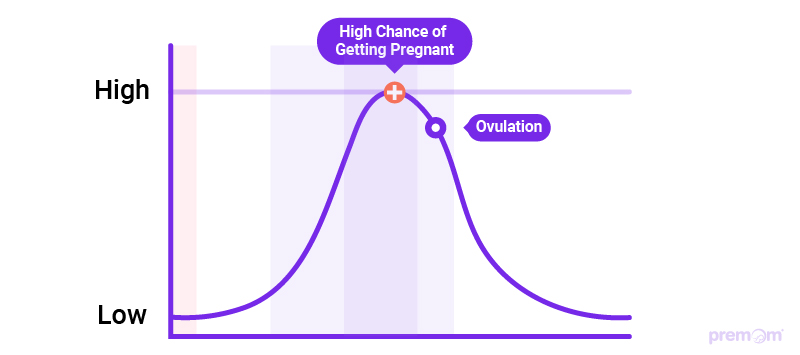After downloading the free Premom ovulation app, many new Premoms (understandably) ask us these most common questions before enjoying their first T/C ratio ovulation test:
- How can I predict my ovulation by tracking my Luteinizing Hormone (LH) levels?
- What’s the difference between T/C ratio and LH levels?
- Why are there two separate tabs in the Premom app for these two categories, and where do I upload my tests?
To help you understand the function and leverage the value of T/C ratio ovulation testing, let’s start with some definitions.
What is a T/C ratio?
Easy@Home qualitative ovulation test strips display 2 lines: the test line (T) and the control line (C). T/C ratio ovulation testing simply compares the color intensity of the
T line to the color intensity of the C line.
How does the Premom app determine whether your Easy@Home qualitative ovulation test is positive? To identify your Luteinizing Hormone (LH) peak, the app looks for a ratio of 1.0 or higher — when the test line is as dark as or darker than the control line.
A test line that’s lighter than the control line will be less than 1.0 and may or may not be considered your LH peak day depending on your patterns. Remember: every woman is unique and presents LH fluctuations differently.
In addition to a positive or negative result, T/C ratio ovulation tests provide insights into your cycle fluctuations, even helping you recognize the approach of your surge
(when your levels approach 0.5 then rise above.)
How To Read a T/C Ratio Ovulation Test
The goal of T/C ratio ovulation testing is to find your highest T/C ratio —also known as your LH peak— to predict your ovulation day. To accomplish it, Premom recommends testing at least 8 days per cycle. After dipping your test strip in afternoon urine and waiting 5 minutes for the dye to rise, open the Premom ovulation tracker app and tap on ‘Tests’ to log your result. Then, use the app’s automatic scan function to take a picture of your ovulation test strip, and it will automatically calculate your T/C ratio while simultaneously building your fertility chart.
Related: How to Use Ovulation Tests
Beyond T/C Ratio Ovulation Testing: Premom’s Quantitative Ovulation Tests
T/C ratio ovulation testing provides only a general idea of your hormone levels. More precise LH levels can be measured only by using Premom’s purple handled quantitative test strips. When reading these tests, you aren’t looking for the test line to be as dark or darker than the control line. Instead, these test strips precisely quantify your LH level from 0 to 65 mIU/mL.
These are particularly beneficial for women over the age of 35 (whose estrogen levels and egg count may be decreasing) and for women who have:
- Irregular cycles
- Elevated LH levels
- Multiple surges
- Hard-to-recognize surges
- PCOS
Premom quantitative tests are read differently: DO NOT put Easy@Home qualitative tests under the Premom tab or your results will be read inaccurately.

For more detailed fertility expert insights into your cycles based on your ovulation test results, leverage Premom’s cycle analysis reports and cycle comparison reports.
Since LH peak levels can vary from woman to woman and even cycle to cycle, the key is to keep testing — even after what appears to be a “positive” or “peak” to make sure you’ve found your true peak and that your LH surge is over.
In other words, keep testing until you see your LH levels dropping and staying down. The Premom app is also looking for this and will not designate a “peak” until the uploaded test after your peak detects a lower LH level. Still have questions? In your Premom app, tap “ASK AI” for more in-depth conversation.
FAQs: T/C Ratio Ovulation Testing & Quantitative Ovulation Testing
Q: How do I read my T/C ratio ovulation tests?
A: You can let the free Premom app do the job for you! The app will automatically compare the color of the test (T) and control (C) lines which creates the T/C ratio. A ratio of 1.0 or higher, when the test line is as dark as or darker than the control line, indicates a positive test. You’ll always look to monitor the progression of the T/C ratio, you’re looking for the last, highest ratio to pinpoint your LH peak day. It’s important to note that an LH peak can vary from woman to woman and cycle to cycle, it can be less than 1 or more than 1. What matters most is the highest LH reading compared to the rest during each cycle.
Q: Do the numbers of my T/C ratios reflect my fertility?
A: Not necessarily. The T/C ratio simply reflects the color difference between the test (T) and control (C) lines on your ovulation test strip, indicating a positive or negative result. If you are unable to find an LH peak after testing twice daily for an entire cycle, you may want to reach out to your provider. Also, note that women with different ratios can all successfully ovulate whether they have an LH peak of 0.8 or an LH peak of 2.3, it’s the last darkest line on your test strip that indicates your LH peak. Your predicted ovulation will likely be within the next 24 hours.
Q: Can a T/C ratio ovulation test tell me my LH hormone level?
A: No, the T/C ratio simply reflects the color difference between the test (T) and control (C) lines on your test strip, indicating positive or negative. If you are interested in seeing a numerical level of LH, try using the Premom quantitative tests.
Q: What is the ideal T/C ratio for successful ovulation?
A: There is no exact number that indicates successful ovulation. A different T/C ratio will trigger ovulation for each woman. Your goal is to find your highest T/C ratio (LH peak), meaning it is the last, darkest line in your ovulation test line progression. After your peak day, your ratio will decrease and not peak again until the next cycle. Ovulation typically follows an LH peak within 24 hours. Because ovulation tests only predict when ovulation is likely to occur, it is recommended to use either an Easy@Home PdG test or track your Basal Body Temperature to gain a better understanding of whether ovulation has taken place.
Q: How do I know if I need to use Premom’s quantitative ovulation test?
Because Premom quantitative ovulation tests provide more precise results than T/C ratio ovulation tests, it’s recommended for women who are 35 years old or older. These quantitative tests are also especially helpful for women who have cycle or hormonal irregularities, which may make qualitative ovulation tests difficult to read.
References
Published: July 21, 2022



